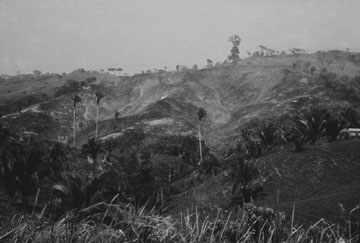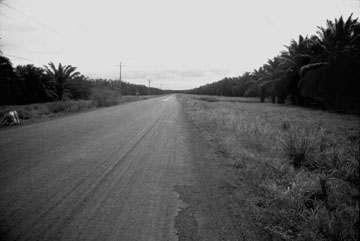|
Since 1959 my wife and I have been studying the cultural ecology of a native people, the Rungus. The Rungus live in Borneo, more specifically in Sabah, part of Malaysian Borneo. The Rungus had a sustainable economy, until the intrusion of multinationals and the global economy. The Rungus used to cut their fields out of the secondary forest, plant rice, maize, and cassava. Along the small river where we lived, the Rungus and we used to bathe every evening in beautiful flowing waters. We were never short of water. After a hiatus of research, we returned in 1986 to the village where we had lived. And we were shocked to find that the river had all but dried up and saplings were now growing in the bed of the river.  and elsewhere throughout the tropics. How can this desiccation of the environment be explained? Government personnel claimed that the desiccation was the result of a change in weather patterns, ignoring the changes in the local environment. Contradicting their position was the discovery during a recent field session of a village nearby our research site that had a stream emanating from the base of a primary forest reserve. And it had never dried up, not once even during the periods of major droughts in Borneo. Obviously there must be more proximate local causes for the desiccation of the environment. And we set out to find these. The first thing that struck us was the destruction of what primary forest previously existed. At the headwaters of the river there was a small gazetted reserve of primary jungle, a significant part of which had been felled. There were other reasons for the change in the hydrological cycle at our field site. Many of the sacred groves had been cut down. The Rungus believed that around springs, seeps, and certain areas along the river banks there lived various spirits. The Rungus did not cut down these groves of trees for fear of angering the indwelling spirits, who would then would cause the cutter or a member of his family to become ill or have an accident. We found it most insightful that the Rungus in our first field session claimed that the cutting down of these sacred groves would result in the drying up of the environment. And they were right! By 1986 we found that the Rungus had become Christians. The missionaries had claimed that if they became Christians they could then cut down these sacred groves with impunity; they would not get sick. Also, there was now a dispensary in the area that could provide medicines if one did become sick. Sacred groves had several functions to play in maintaining a healthy hydrological cycle. A multistoried, heavily canopied forest breaks the impact of the rainfall, allowing the water to trickle down branches and tree trunks. This slows the run-off of the rainfall by permitting water to soak into the soil, and deep roots aid in this infiltration. I made several observations of the time between the end of rainfall and the cessation of leaf drip in a grove of secondary forest. There was a continuous drip of significant rain water from leaf to leaf for over 18 hours afterwards. Thus, with a forest cover rainfall percolates steadily into the soil and runs off into the rivers at a gradual rate (see Myers 1984:262), rather than rushing out to sea from those areas with minimal forest cover. This also minimizes floods and the environmental harm of large flooding. The high transpiration rate of such forests returns water to the atmosphere to fall again as rain. Thus, when the forest cover remains intact it acts as a sponge, slowing the runoff and releasing moisture at a slow regular rate (Myers 1984:262, 281). Furthermore, the transpiration from trees in the groves provides hygroscopic nuclei for stimulating condensation in a humid environment and creating rainfall. Cutting of the sacred groves had also resulted in the destruction of the forest along river banks. This exposed the river and the pools in which we used to swim to the sun and rapid evaporation. Critical to these hydrological processes was that the springs in the formerly sacred groves dried up or lessened their flow. What were the factors behind this? Our understanding of sacred groves as a source for maintaining a functioning hydrologic cycle is of course far from complete. But there has been a recent discovery by plant ecologists which supports naturalistic observations by the Rungus themselves. It has been discovered that trees bring significant amounts of underground water to the surface. In the night, "many plants pull up water from deep in the earth and, rather than holding on to it to pass through their leaves the next day, they flush it out through their shallow roots into the ground around them" (Yoon 1993:C1; see Dawson 1993a, 1993b). Trees in this manner lift water that is stored deep in the ground. For example, it has been estimated that a 40 foot tall sugar maple can deliver between 40 and 50 gallons of water to the upper soil layers every night (see Dawson 1993a, 1993b). This has been termed hydraulic lift.  The effects of this hydraulic lift in sacred groves were observed by some Rungus. Sources pointed out that in the morning one could see a mist rising from the ground in these groves, indicating that these groves were a source of water. During field work I explained the concept of hydraulic lift to several Rungus friends. The Assistant Native Chief on hearing this exclaimed that this explained an observation he had made of a sacred grove in his youth. When he passed it in the morning on the way to his fields, a stream was running out of it. But on the way back in the late afternoon, he could cross this stream bed without getting his feet wet. The stream had dried up. Even in classical times in Greece and Rome, Hughes and Thirgood (1982:202) point out, there were observations on the impact of deforestation on the hydrological cycle and its consequences in desiccating the environment. Rather than controlling the destruction of forest at the headwaters of various rivers and introducing sustainable forestry, rather than preserving the sacred groves, the government took the step of building a system of aqueducts and piping to bring water to the Rungus villages and the nearby town. This project cost over $40 million dollars, more than all the profit taken from destruction of the forest. First, clear-cutting should have a similar impact on the hydrological cycle. We could expect a change in rainfall patterns, with less occurring in areas with maximal clear-cutting. Furthermore, the hydrological cycle is speeded up. After rainfall, water moves more rapidly out of the ecosystem. This results in larger flooding and greater property damage downstream from clear-cutting. Without shade, the snow melt becomes more rapid, increasing the spring flooding. Second, there will also be a change in the aquafauna of the streams. The temperature of the streams heats up, causing a change in the habitat and fauna of the stream. Third, we found in Borneo that the cutting of the sacred groves resulted in a pauperization of other fauna. There was less diversity of fauna, less diversity of flora, and smaller numbers of what fauna did remain. Fourth, among the Rungus there was an increase in pests that preyed on their crops. Will this also occur in Maine? Fifth, in the Rungus area the government introduced a species of tree from Australia to establish plantations of fiber for the proposed paper industry. This species has now escaped and is taking over the native forest, causing much damage to the ecosystem. It consumes more water from the soil than native trees, so that the soil becomes much drier. And it consumes incredible amounts of nutrients from the soil so that when the trees are cut, little else useful will grow there. Will reforestation of exotic trees in Maine result in the erosion of the natural forest community, impact on the hydrological cycle, and produce a change in the fauna that depends on the native forest? Finally, there has been a loss of species of plants and microorganisms that might have had an economic value, such as soil bacteria, that might have a useful medical value. The unexpected consequences of clear-cutting in Maine have not been fully explored. But our research in Borneo suggests what they might be...lowered stream flow except after heavy rains or rapid snow melt, when floods will be experienced downstream...a shift in rainfall patterns...a loss of species in the rivers, in the decimated forest, and in the soil. When an ecosystem is destroyed or heavily modified it has an impact on all those organisms that are part of that ecosystem. And this includes humans. As a consequence, the populations involved may indeed experience a shift in their overall health. Social change has that unintended consequence. Thus, the value of nature's services are never considered or accounted for by those in the business community and seldom by government personnel, particularly the elected members. Instead they continue to pander to the most popular view of the natural world: It is out there for our use and profit. The costs entailed in the destruction of these services are instead externalized to the citizenry either through health problems, physical harm (such as in floods or poor air), taxes to rebuild those bridges and buildings destroyed by the floods or to prevent further flooding, and still a myriad of unaccounted and as yet undetermined costs from the loss of species diversity, some of which might have been of benefit for humankind. Instead the paper companies externalize these costs to the larger community so that businesses, citizens of Maine, children and schools will be paying the costs. Forest product companies make a profit after
their costs of sales are subtracted from their sales. This is
distributed to stockholders of these companies and to the top
executives. Yet their construction of costs is incomplete. The
profits shared by executives and stockholders are at a cost to
the Maine citizenry. The Maine citizenry, by paying for the as
yet unaccounted costs of clear-cutting, are contributing to the
forest product companies' profits. While the company does contribute
to the state 's economy through the jobs it produces, is this
contribution anywhere near
New England Power Uses Your Money To Support Sustainable Forestry in Borneo But Not In Maine Probably the most ironic development of all is that we use American profits off American taxpayers to promote proper logging in tropical countries and ignore the benefits that might come from doing the same here where we live. One of the unaccounted costs borne by those in the region who buy power from New England Power Company is the company's payments to subsidize tropical forestry. In 1992 the company entered into an agreement with a government controlled timber company in Malaysian Borneo to fund a reduced impact logging program on a 1400-hectare plot. "Mindful of possible carbon taxes in Massachusetts and with ambitious corporate targets to meet reducing pollution in the 1990s, NEP has agreed to fund a 1400-hectare pilot program of 'Reduced Impact Logging'. The idea is to save vegetation, and thus sequester carbon, from incidental damage during logging: when destroyed vegetation rots it releases carbon dioxide into the atmosphere. The 3-year contract... will cover all the additional cost of training and consultancy required for harvesting to the highest environmental standards, including... skid-trail planning, directional felling, minimal uses of bulldozers, etc... The NEP contract is also funding a short study of the net carbon dioxide savings from reduced impact logging" (Marsh 1993:3). G.N.A.
Dawson, Todd E. 1993b Hydraulic Life and Water Use by Plants:
Hughes, J. Donald and J. V. Thirgood Marsh, Clive Yoon, Carol Kaesuk
|